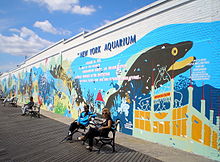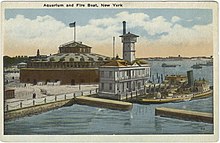New York Aquarium
This article needs additional citations for verification. (August 2013) |
 South wall | |
| Date opened | December 10, 1896 |
|---|---|
| Location | 602 Surf Avenue Brooklyn, New York 11224 United States |
| Coordinates | 40°34′27″N 73°58′30″W / 40.574292°N 73.975116°WCoordinates: 40°34′27″N 73°58′30″W / 40.574292°N 73.975116°W |
| Land area | 14 acres (5.7 ha) |
| Memberships | AZA[1] |
| Public transit access | Subway: Bus: |
| Website | www |
The New York Aquarium is the oldest continually operating aquarium in the United States, located on the Riegelmann Boardwalk in Coney Island, Brooklyn, New York City. It was founded at Castle Garden in Battery Park, Manhattan in 1896, and moved to Coney Island in 1957. The aquarium is operated by the Wildlife Conservation Society (WCS) as part of its integrated system of four zoos and one aquarium, most notably the Bronx Zoo. It is accredited by the Association of Zoos and Aquariums (AZA). As part of WCS, the aquarium's mission is to save wildlife and wild places worldwide through science, conservation action, education, and inspiring people to value nature.
The facility occupies 14 acres (5.7 ha) and boasts 266 species of aquatic wildlife. Its mission is to raise public awareness about issues facing the ocean and its inhabitants with special exhibits, public events and research. The New York Seascape program, based out of the aquarium, is WCS’s local conservation program designed to restore healthy populations of marine species and protect New York waters, which are vital to the area’s economic and cultural vitality.
History[]
Battery Park location[]

The New York Aquarium opened on December 10, 1896, at Castle Garden in Battery Park. Its first director was Tarleton Hoffman Bean (1895–1898). He was instrumental in helping to create similar wild life organizations, especially aquaria. On October 31, 1902, the Aquarium was put under the administration of the New York Zoological Society. At the time, the Aquarium housed only 150 specimens of wildlife. Over time, its most famous director, the distinguished zoologist Charles Haskins Townsend, enlarged the collections considerably, and the Aquarium attracted hundreds of thousands of visitors each year. A towering figure in New York Zoological Society and New York Aquarium history, Doctor Townsend served as the Aquarium's director for thirty years. Townsend's work with whaling bans, Galápagos tortoise conservation and the development of aquarium technology are on par with the work of William Temple Hornaday.[2]
Early in October 1941, the Aquarium at Battery Park was controversially closed based on claims of NYC Parks Commissioner Robert Moses that the proposed construction of the Brooklyn–Battery Tunnel from Lower Manhattan to Brooklyn might undermine Castle Clinton's foundation. Many of the Aquarium’s sea creatures were temporarily housed at the Bronx Zoo until the new aquarium was built after World War II.
Brooklyn location[]
On June 6, 1957, the Aquarium opened at its new location in Coney Island, Brooklyn. The new site of the New York Aquarium is the home of the WCS New York Seascape program – the society’s research and conservation program focusing on nearby rivers, harbor, and ocean from Cape May, New Jersey to Montauk, Long Island.[3]
The aquarium kept an orca briefly in 1968 and a narwhal in 1969. Both reportedly died of possible pneumonia.[4][5] The aquarium's beluga whales were transferred to the Georgia Aquarium in 2007 as part of a breeding program.[6] In September 2011, the aquarium named its new electric eel Wattson,[7] and in March 2012, it launched a sea horse breeding program.[8]
In October 2006, the New York Aquarium announced the finalists to a competition to develop a more inviting and visually prominent exterior for the aquarium.[9] In March 2007, the winning design by firms WRT and Cloud 9 was selected, which featured an enclosure resembling a whale over the aquarium.[10][11] However, in March 2008, that concept was scrapped due to concerns over the cost of the design and the practicality of constructing future exhibits under the enclosure.[12] Instead, plans for a new exhibit based on sharks were announced.[13] The massive 784,000-US-gallon (2,970,000 l), 57,000-square-foot (5,300 m2) exhibition, Ocean Wonders: Sharks!, was originally scheduled to break ground in November 2012 and open in 2015.[14] However, the New York Aquarium was significantly damaged by Hurricane Sandy in October 2012, which severely flooded the facility and shut down power. A small group of WCS staff who remained onsite during the hurricane were able to save 90 percent of the animals in the collection.[15] As a result, construction on the exhibit was delayed.[16] Ocean Wonders: Sharks! ultimately broke ground in January 2014.[17] The exhibit opened on June 30, 2018, becoming the first major exhibit at the New York Aquarium to open after Hurricane Sandy.[17][18][19]
The aquarium closed for four months starting in March 2020 due to the COVID-19 pandemic in New York City, which shuttered almost all businesses citywide. With the reopening of the aquarium in July 2020, a new exhibit called Spineless, dedicated to invertebrate marine species, was opened.[20]
Exhibits[]
As of 2018, the New York Aquarium consists of five exhibits: Aquatheater; Conservation Hall; Sea Cliffs; Spineless; and Ocean Wonders: Sharks.[21]
The original Bathysphere, a deep-sea submersible that made historic journeys underwater in the 1930s, is on display at the aquarium.[22]
Notable people[]
- Charles Haskins Townsend served as director from 1902 to 1937.
- Ida May Mellen worked at the New York Aquarium from 1916 to 1929.
- James Arthur Oliver was director from 1970 until 1976. Oliver also held directorships at the Bronx Zoo and the American Museum of Natural History during his career - the only person to have been director of all three institutions.
References[]
- ^ "Currently Accredited Zoos and Aquariums". aza.org. AZA. Retrieved May 27, 2010.
- ^ "Castle Clinton". History & Culture. National Park Service. Retrieved June 19, 2017.
- ^ "A New New York Aquarium". Huffington Post. Retrieved February 7, 2016.
- ^ "NY Whale Dies in Pool". Eugene Register-Guard. Retrieved March 9, 2017.
- ^ "Aquarium's Narwhal Is Dead". St. Petersburg Times. Retrieved March 9, 2017.
- ^ Belugas sent to breed Archived January 5, 2009, at the Wayback Machine
- ^ "The Neighborhood News". New York. September 26, 2011. p. 20.
- ^ "The Neighborhood News". New York. March 18, 2012.
- ^ Confessore, Nicholas (October 6, 2006). "From 3 Finalists in Aquarium's Redesign, Swoops, Swirls and Great Water Views". The New York Times. ISSN 0362-4331. Retrieved December 15, 2018.
- ^ Chung, Jen. "NY Aquarium Goes for "Whale" of a Design". Gothamist. Archived from the original on March 12, 2018. Retrieved December 15, 2018.
- ^ "Enric Ruiz-Geli | Projects in progress : New York Aquarium". www.ruiz-geli.com. Retrieved December 15, 2018.
- ^ Mindlin, Alex (March 23, 2008). "300,000 Gallons of 'Jaws'". The New York Times. ISSN 0362-4331. Retrieved December 15, 2018.
- ^ Robert (March 3, 2008). "Swimming with Sharks: $67M Coney 'Fantasy Land'". Curbed NY. Retrieved June 29, 2018.
- ^ Plitt, Amy (June 29, 2018). "New York Aquarium's new, kinetic shark pavilion opens at Coney Island". Curbed NY. Retrieved June 29, 2018.
- ^ "New York Aquarium damaged by Hurricane Sandy". The New York Times. Retrieved April 6, 2013.
- ^ Stapinski, Helene (May 5, 2017). "Rebuilding the New York Aquarium After Hurricane Sandy". The New York Times. ISSN 0362-4331. Retrieved May 5, 2017.
- ^ Jump up to: a b "New York Aquarium To Debut New Sharks Exhibit". June 8, 2018. Retrieved June 29, 2018.
- ^ Schneider, Katy (June 28, 2018). "What to Know About the New York Aquarium's New Shark Building". Daily Intelligencer. Retrieved June 29, 2018.
- ^ Kimmelman, Michael (June 28, 2018). "Coney Island's Newest Wonder: Sharkitecture!". The New York Times. ISSN 0362-4331. Retrieved July 10, 2020.
- ^ "Reopen NYC: Bronx Zoo, New York Aquarium, Central Park Zoo, Prospect Park Zoo, and Queens Zoo reopening on July 24 with safety protocols". ABC7 New York. July 9, 2020. Retrieved July 10, 2020.
- ^ "Exhibits - New York Aquarium". Retrieved September 22, 2019.
- ^ Poffenberger, Leah (August–September 2018). "This Month in Physics History". American Physical Society. Retrieved October 3, 2018.
External links[]
| Wikimedia Commons has media related to New York Aquarium. |
- Official website
- New York Aquarium on zooinstitutes.com
- 1896 establishments in New York (state)
- Aquaria in New York (state)
- Coney Island
- Entertainment venues in Brooklyn
- Environmental organizations based in New York City
- Tourist attractions in Brooklyn
- Wildlife Conservation Society
- Zoos in New York City



